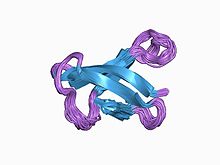| Antifungal_prot | |||||||||
|---|---|---|---|---|---|---|---|---|---|
 solution structure of the antifungal protein from aspergillus giganteus. evidence for disulphide configurational isomerism solution structure of the antifungal protein from aspergillus giganteus. evidence for disulphide configurational isomerism | |||||||||
| Identifiers | |||||||||
| Symbol | Antifungal_prot | ||||||||
| Pfam | PF11402 | ||||||||
| InterPro | IPR022706 | ||||||||
| |||||||||
The antifungal protein family is a protein family, with members sharing a structure consisting of five antiparallel beta strands which are highly twisted creating a beta barrel stabilised by four internal disulphide bridges. A cationic site adjacent to a hydrophobic stretch on the protein surface may constitute a phospholipid binding site.
Penicillium
PAF (Q01701) and PAFB (D0EXD3) are two members of PF11402 from Penicillium chrysogenum. PAF exhibits growth-inhibitory activity against a broad range of filamentous fungi. Evidence suggests that disruption of Ca signaling/homeostasis plays an important role in the mechanistic basis of PAF as a growth inhibitor. PAF also elicits hyperpolarization of the plasma membrane and the activation of ion channels, followed by an increase in reactive oxygen species in the cell and the induction of an apoptosis-like phenotype
PAF and PAFB are well-tolerated by mamallian and plant cells. They have proposed uses in medicine.
In humans
Human epithelium produces antifungal protein S100A7, which is not a member of this protein family. Instead, S100A7 belongs in the S100 protein family. The proteins kill fungi by inducing apoptosis and/or forming pores on the cell membrane.
References
- ^ Campos-Olivas R, Bruix M, Santoro J, Lacadena J, Martinez del Pozo A, Gavilanes JG, Rico M (March 1995). "NMR solution structure of the antifungal protein from Aspergillus giganteus: evidence for cysteine pairing isomerism". Biochemistry. 34 (9): 3009–21. doi:10.1021/bi00009a032. PMID 7893713.
- Binder U, Chu M, Read ND, Marx F (Sep 2010). "The antifungal activity of the Penicillium chrysogenum protein PAF disrupts calcium homeostasis in Neurospora crassa". Eukaryotic Cell. 9 (9): 1374–82. doi:10.1128/EC.00050-10. PMC 2937333. PMID 20622001.
- Marx F, Binder U, Leiter E, Pócsi I (Feb 2008). "The Penicillium chrysogenum antifungal protein PAF, a promising tool for the development of new antifungal therapies and fungal cell biology studies". Cellular and Molecular Life Sciences. 65 (3): 445–54. doi:10.1007/s00018-007-7364-8. PMC 11131716. PMID 17965829. S2CID 35186093.
- Huber, A.; Galgóczy, L.; Váradi, G.; Holzknecht, J.; Kakar, A.; Malanovic, N.; Leber, R.; Koch, J.; Keller, M.A.; Batta, G.; Tóth, G.K.; Marx, F. (August 2020). "Two small, cysteine-rich and cationic antifungal proteins from Penicillium chrysogenum: A comparative study of PAF and PAFB". Biochimica et Biophysica Acta (BBA) - Biomembranes. 1862 (8): 183246. doi:10.1016/j.bbamem.2020.183246. PMC 7138148.
- ^ Hein, Kyaw Zaw; Takahashi, Hitoshi; Tsumori, Toshiko; Yasui, Yukihiko; Nanjoh, Yasuko; Toga, Tetsuo; Wu, Zhihong; Grötzinger, Joachim; Jung, Sascha (2015-10-20). "Disulphide-reduced psoriasin is a human apoptosis-inducing broad-spectrum fungicide". Proceedings of the National Academy of Sciences of the United States of America. 112 (42): 13039–13044. Bibcode:2015PNAS..11213039H. doi:10.1073/pnas.1511197112. ISSN 1091-6490. PMC 4620902. PMID 26438863.